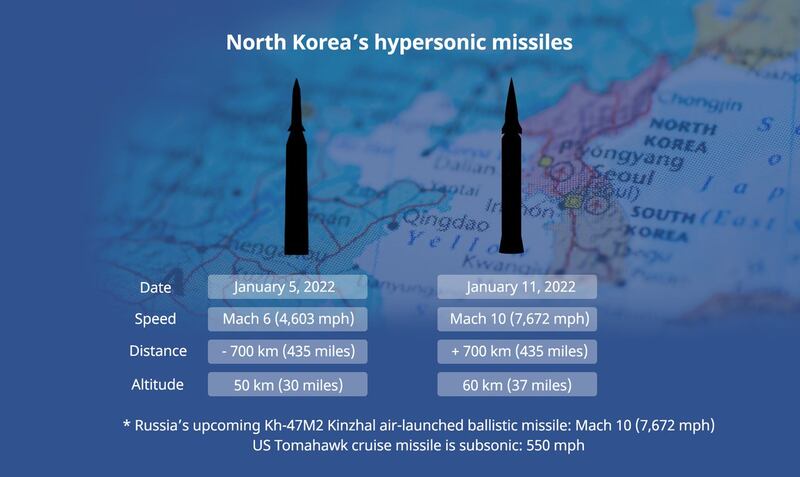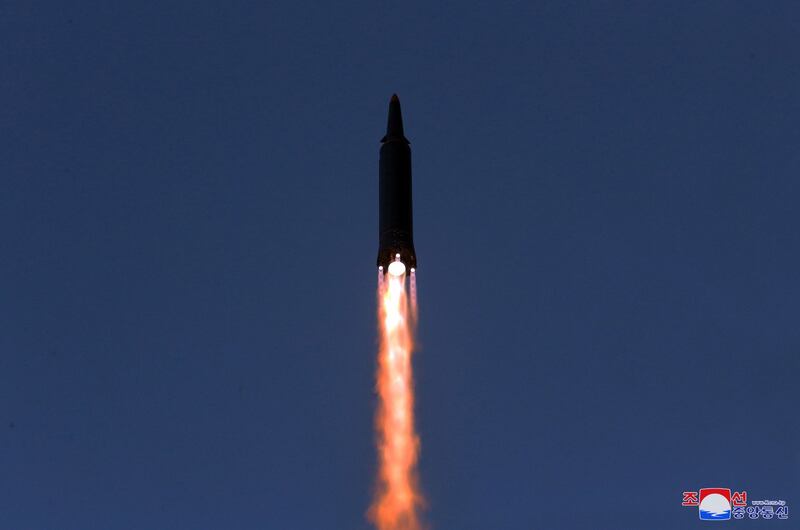North Korea test launched a ballistic missile Tuesday capable of speeds exceeding Mach-10, displaying an apparent technological advance in its second hypersonic test of 2022, South Korea’s military said.
The launch came less than a week after Pyongyang tested another hypersonic missile, but Tuesday’s was likely more advanced. If so, the test would seem to meet North Korean leader Kim Jong Un’s New Year’s Day promise to increase military capabilities through advanced technology as talks with South Korea and the U.S. have stalled.
But analysts said it was too soon to determine how big of a technological advancement Tuesday’s test represented.
Early findings estimate that the missile travelled eastward from the northern province of Chagang into waters east of the peninsula, about 770 km (435 miles) away, South Korea’s Joint Chiefs of Staff said in a statement.
The missile reached a maximum height of 60 kilometers (37 miles), with a speed of up to 10 times the speed of sound.
"We assess that this is more advanced than the missile North Korea fired on Jan. 5, though South Korean and U.S. intelligence authorities are conducting detailed analysis," the JCS said.
That missile was also claimed by North Korea to be hypersonic–fast enough to thwart defenses–but the South Korean defense ministry said this exaggerated the capabilities, and the missile was merely a slight upgrade over a ballistic missile. A U.S. weapons expert also said the focus on speed was misplaced.

A U.S. State Department spokesperson told RFA’s Korean Service the test was a “violation of multiple U.N. Security Council Resolutions and poses a threat to [North Korea’s] neighbors and the international community.”
The U.S. Indo-Pacific Command said in a statement that although the launch did not “pose an immediate threat to U.S. personnel or territory, or to our allies, the missile launch highlights the destabilizing impact of the DPRK’s illicit weapons program.”
U.N. Secretary General António Guterres, through a spokesperson, expressed concern over the launch, and reiterated that diplomatic engagement was the only way to reach a solution to the denuclearization of the Korean peninsula.
Several experts, both in South Korea and the U.S. said they expected that North Korea will continue to test weapons systems.
“The reason why North Korea conducts these tests every few days is to complete the development of strategic weapons and nuclear weapons to an irreversible level,” Hong Min, director of the North Korea Research Division at the Seoul-based Korea Institute for National Unification, told RFA.
“It seems to be a series of actions in the beginning of the process to make sure that it is a matter of sovereignty at the level of self-defense as the international community continues to raise issues,” Hong said.

The two launches appear to be efforts to perfect a hypersonic vehicle, Robert Manning of the Washington-based Atlantic Council told RFA.
“You have to keep in mind, the only way to know if missiles work as intended is to test them,” he said. “Expect more. One troubling thing is that when you look at the whole set of nuclear and missile capabilities that Kim Jong Un is building, they appear more than what would be needed to deter the U.S.
Manning said the testing could affect South Korea’s ongoing presidential race.
Nam Seong-wook of Korea University told RFA that the launch could be an effort to distract North Koreans from the economic difficulties they face due to the COVID-19 pandemic and continued sanctions over their country’s nuclear program.
But the launch hints at the possibility of a preemptive nuclear strike against the South, Cha Du Hyeogn of the Seoul-based Asan Institute said in a video released Tuesday.
“No matter how much sanctions are imposed, North Korea’s weapons are advancing. In particular, its nuclear capabilities will continue to advance,” he said.
Soo Kim of the RAND Corporation told RFA that Kim Jong Un will likely continue to test missiles without a firm declaration from the U.S. of the consequences of doing so.
“Kim likely assesses that the demonstration of weapons capabilities helps him maintain the upper hand in any future dealings with the U.S. Plus, it perpetuates the regime’s looming presence over its neighbor, South Korea,” Soo Kim said.
Two launches within a week served to bolster North Korea as a potential threat to the international community, she said.

The timing of the launch was meant to coincide with a meeting of the U.N. Security Council on Tuesday over North Korea’s launch last week, David Maxwell of the Foundation for the Defense of Democracies told RFA.
He also noted that South Korea went from “being skeptical as to whether the 6 January launch was a hypersonic missile to reporting on the 11 January launch being Mach 10."
But Joshua Pollack, senior research associate at the Middlebury Institute of International Studies at Monterey, California, said the significance of the most recent test was not clear.
“The problem with the term ‘hypersonic’ is that all ballistic missiles of more than a relatively short range meet the usual definition. So, strictly speaking, both North and South Korea have had hypersonic missiles for years, even for decades,” Pollack said.
The term can be applied both to cruise missiles and ballistic missiles that travel faster than Mach 5. Hypersonic usually refers only to the “boost speed” of a missile — that is the speed that it reaches powered by its fuel. Two identical ballistic missiles that boost at different speeds will glide back to earth at the same speed once the rocket burns out.
“All of this emphasis on speed and Mach numbers can be very confusing and is perhaps pointless. … If speed is what matters, then I simply cannot explain what the big deal about Mach 10 is. The Hwasong-15 ICBM burns out at roughly Mach 20,” he said, referring to a missile North Korea first test launched in 2017.
Translated by Leejin Jun. Written in English by Eugene Whong.
